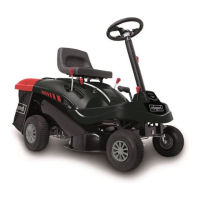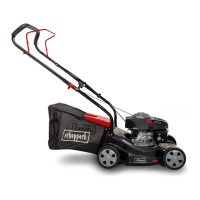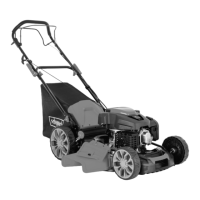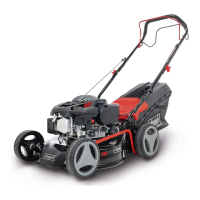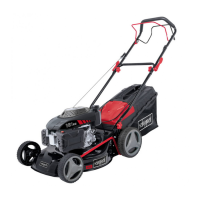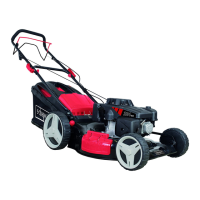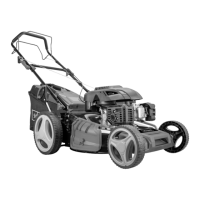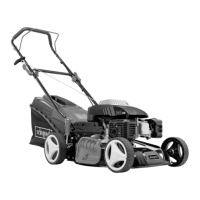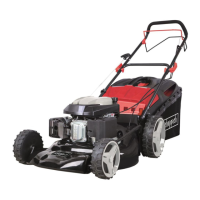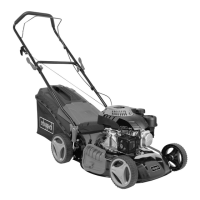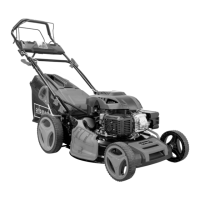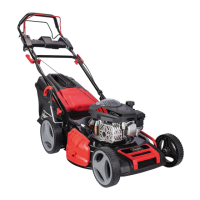www.scheppach.com service@scheppach.com +(49)-08223-4002-99 +(49)-08223-4002-58 www.scheppach.com service@scheppach.com +(49)-08223-4002-99 +(49)-08223-4002-58
40
|
GB
Use the machine with great care when working near
slopes, terraces, ditches and embankments. In par-
ticular, ensure that you maintain sucient distance to
such danger areas.
Particular care must be taken at points of poor visibil-
ity, bushes, trees and other obstacles, behind which
persons, especially children, or animals may be hid-
den.
Bring the ride-on mower to a standstill immediately
and stop the mowing blade if someone moves into the
area to be mown.
Always monitor the area in front of the vehicle. Be-
ware of obstacles, in order to be able to evade them
in time.
Before reversing, always check the area behind the
ride-on mower and, if present, disengage the attach-
ment. Never mow in reverse, if it is not absolutely
necessary. When mowing in reverse, take particular
care and before beginning to mow, thoroughly check
the entire area behind the ride-on mower.
When working together in a group, always inform the
others in advance of what you intend to do. Maintain
a safety distance!
The vehicle speed must be reduced before each
change of direction, so that the user retains control
of the machine at all times and also that the ride-on
mower cannot tip over.
When operating near to roads and when crossing
roads, other road users must be taken into account.
Take particular care when mowing near roads, cycle
paths and footpaths. Objects which are thrown up by
the mower can cause severe injury and damage.
mHandling petrol
m Danger to life! Petrol is poisonous and ex-
tremely inammable.
Petrol must only be stored in appropriate, tested con-
tainers (canisters). Always screw on the fuel tank and
canister caps properly and tightly. Defective caps
must be replaced for safety reasons.
Keep petrol away from sparks, naked ames, pilot
lights, heat sources, and other ignition sources. Do
not smoke!
Rell the tank out-of-doors and do not smoke during
relling.
Before relling the tank, stop the engine and allow it
to cool.
Relling with petrol must be performed before the en-
gine is started. When the engine is running or is hot,
the tank cap must not be removed and the tank must
not be relled with petrol.
Open the fuel tank cap slowly and carefully. Wait for
pressure compensation and only then remove the
tank cap completely.
Use a suitable funnel or lling pipe for relling the
tank, so that no fuel can spill onto the engine and
housing or the lawn.
Do not overll the fuel tank!
To give the fuel room to expand, never ll the fuel tank
past the lower edge of the ller neck. Observe the ad-
ditional instructions in the engine instruction manual.
If petrol is spilled, the engine must only be started
after the petrolcontaminated area has been cleaned.
All attempts at starting must be avoided until the pet-
rol fumes have dispersed (wipe dry).
Any spilt fuel must be wiped up immediately.
Clothing must be changed if it comes into contact
with petrol.
Following each relling of the tank, the fuel tank cap
must be properly screwed on and tightened. The ma-
chine must not be operated without the original tank
cap.
For safety reasons, the fuel line, fuel tank, tank cap
and connections must be checked regularly for dam-
age, ageing (brittleness), rm seating and leaks. Re-
place if necessary.
If it is necessary to drain the tank, this must be done
out of doors.
Never use beverage bottles or similar for disposal or
storage of fuels and lubricants. Persons, particularly
children, could be tempted to drink out of them.
Never store the machine with petrol in the tank inside
a building. The resulting petrol fumes could come into
contact with naked ames or sparks and could be ig-
nited.
Do not leave the machine and the fuel tank close to
heating systems, radiant heaters, welding equipment
and other sources of heat. Explosive hazard!
If, during operation, a defect in the tank, tank cap or in
the fuel-carrying components (fuel lines) is detected,
the engine must be stopped immediately. A specialist
dealer must then be contacted.
